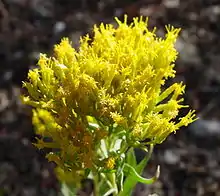Chrysothamnus
Chrysothamnus, known as rabbitbrush, rabbitbush, and chamisa, are shrubs in the sunflower family.[2][3][4] The native distribution is in the arid western United States, Canada, and northern Mexico. It is known for its bright white or yellow flowers in late summer.[1]
| Chrysothamnus | |
|---|---|
 | |
| Chrysothamnus viscidiflorus | |
| Scientific classification | |
| Kingdom: | Plantae |
| Clade: | Tracheophytes |
| Clade: | Angiosperms |
| Clade: | Eudicots |
| Clade: | Asterids |
| Order: | Asterales |
| Family: | Asteraceae |
| Tribe: | Astereae |
| Genus: | Chrysothamnus Nutt. |
| Synonyms[1] | |
| |
Chrysothamnus may grow up to a 120 cm (47 in) tall shrub or subshrub, usually with woody stem bases.[1] The leaves are alternate, sessile or with short petioles, with entire edges. The flowerheads are singular or in clusters. Each composite flower often has five to 6 (though sometimes upwards of 40) yellow disc florets and no ray florets.[1]
Chrysothamnus species are used as food plants by the larvae of some Lepidoptera species including Coleophora linosyridella, Coleophora viscidiflorella (which have both been recorded on C. viscidiflorus) and Schinia walsinghami.
- Chrysothamnus depressus – dwarf rabbitbrush, longflower rabbitbrush – California Nevada Arizona Utah Colorado New Mexico
- Chrysothamnus eremobius – pintwater rabbitbrush, remote rabbitbrush – Nevada
- Chrysothamnus greenei – Greene's rabbitbrush – California Nevada Arizona Utah Colorado New Mexico Wyoming
- Chrysothamnus humilis – Truckee rabbitbrush – California Nevada Oregon Washington Idaho
- Chrysothamnus molestus – Arizona rabbitbrush – Arizona
- Chrysothamnus scopulorum – Arizona Utah
- Chrysothamnus stylosus – Arizona Utah
- Chrysothamnus vaseyi – Vasey's rabbitbrush – Arizona Utah New Mexico Colorado Wyoming
- Chrysothamnus viscidiflorus – yellow rabbitbrush – British Columbia Washington Oregon California Arizona Nevada Idaho Montana Wyoming Utah Colorado New Mexico South Dakota Nebraska
References
- Flora of North America, Rabbitbrush, Chrysothamnus Nuttall, Transactions of the American Philosophical Society, new series 7: 323. 1840.
- Nuttall, Thomas. 1840. Transactions of the American Philosophical Society, new series 7: 323–324. in English
- Tropicos, Chrysothamnus Nutt.
- USDA Plants Profile for Chrysothamnus (rabbitbrush)
- Flann, C (ed) 2009+ Global Compositae Checklist Archived 2014-11-14 at Archive.today
- Biota of North America Program 2013 county distribution maps
External links
| Wikimedia Commons has media related to Chrysothamnus. |